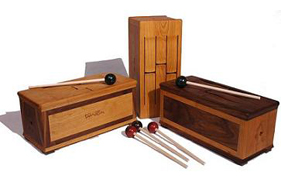
Just try it out. With children big and small. Use musical instruments as decorative items. Leave them lying around and see how people react.
Maybe you’re thinking about the djembe, flute and synthesizer? Interesting. But have you ever heard of the tamböa, cajón and darbouka?
The tamböa is one of the most discreet percussion instruments. The designers based it on slit drums. The tamböa is small, giving it more than one advantage. You don’t need to cross the ocean or continent to find one. They are made in Quebec using cherry and/or black walnut essences.
The tamböa is melodious, with a selection of pentatonics (five tones). It’s ideal for apprentices and leading musicians and it’s easy to use. You play it with one, two or three mallets with rubberized ball heads (like a SuperBall) or simply with your fingers. Its musicality is quite harmonious. It looks like a brand name cigar box. It fits with any style or era of decor.
With its 50 cm height by 30 cm depth and width, the coated wood cajòn can be used as a chair. Once you’re sitting on it, feel free to kick the front part with your heels! You can also bang on it with your hands. Peruvians have been playing the cajón this way since the 18th century.
Legend has it that these parallelepiped soundboards were used to gather fruit or for fishing in slavery times.
All sorts of material blend with the cajón: guitar strings, bells, etc. Traditionally, the hole is in the back, but some musicians set it on its side. Depending on the material chosen and the position of the body versus the instrument―sitting on it or placed between the legs―the instrument makes different sounds that resemble bongos, guitars, bass guitars, drums, castanets, etc. From the rock of Boyce Avenue to the flamenco of Brazilian percussionist Rubem Dantas (es), renowned musicians with completely different styles have and still use the cajón.
We are more familiar with the darbouka, which has a dozen different names. Even though it has no connection to the djembe, according to our sources it is part of the membranophone* family. With over 3000 years of history, the darbouka is traditionally made with a ceramic base and an animal skin stretched over the hole at the top. Too fragile to be transported and sensitive to humidity, these materials have given way to wood and synthetic skin.
When a tambourine is not on taught skin (*membranophone), it can be protected with a solid polymer Plexiglas (trademark) and be used as a side table. Egyptian or Turkish in style, it attracts the eye; it’s a conversation piece and incites you to follow the rhythm of the music of your heart!
Let your imagination run wild by adapting these instruments to your taste. These percussion instruments will definitely add life to your décor and your home!
Thanks to Gilles Perrault of Atelier Petite Californie (Tamböa.com) and Wikipedia for information on the cajón and the darbouka.
Tamböa: https://www.tamboa.com/fr/percussion
Darbouka: https://fr.wikipedia.org/wiki/Darbouka
Cajon: https://fr.wikipedia.org/wiki/cajon